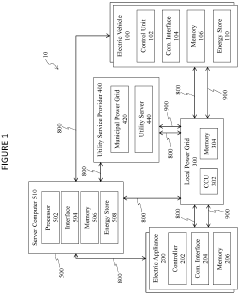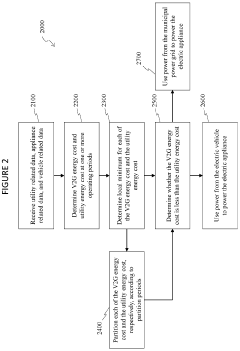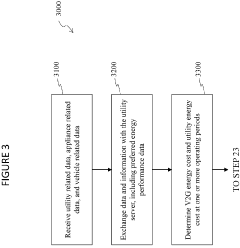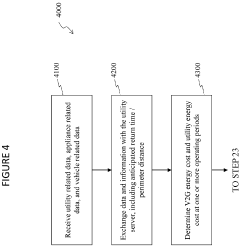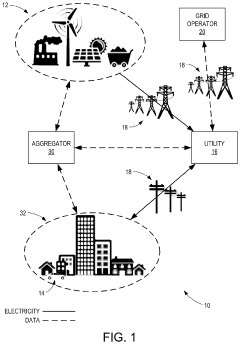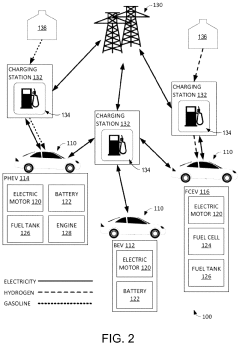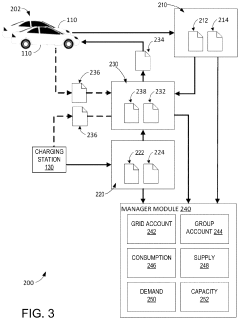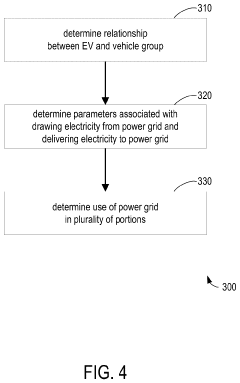Vehicle-to-Grid: Innovations Bridging the Energy Gap
SEP 23, 20259 MIN READ
Generate Your Research Report Instantly with AI Agent
Patsnap Eureka helps you evaluate technical feasibility & market potential.
V2G Technology Background and Objectives
Vehicle-to-Grid (V2G) technology represents a paradigm shift in how we conceptualize the relationship between electric vehicles (EVs) and the power grid. Emerging in the early 2000s through pioneering work by Dr. Willett Kempton at the University of Delaware, V2G technology transforms EVs from mere consumers of electricity into dynamic, bidirectional energy resources capable of both drawing power from and feeding it back to the grid.
The evolution of V2G technology has been closely tied to the broader development of electric mobility and smart grid infrastructure. Initial concepts focused primarily on peak load reduction, but as renewable energy integration challenges emerged, V2G's potential role in grid stabilization and energy storage gained prominence. The technology has progressed from theoretical models to small-scale demonstrations, and now stands at the threshold of commercial deployment in several markets globally.
Current technological trends indicate a convergence of V2G with other emerging technologies, including artificial intelligence for predictive energy management, blockchain for secure energy transactions, and advanced battery management systems that optimize battery longevity while participating in grid services. This convergence is creating new possibilities for distributed energy resource management that were previously unattainable.
The primary objective of V2G technology development is to create a seamless, bidirectional interface between EVs and the electrical grid that maximizes value for both vehicle owners and grid operators. This includes developing robust communication protocols, efficient power electronics, and sophisticated control algorithms that can respond to grid signals in real-time while respecting vehicle owner preferences and battery constraints.
Secondary objectives include minimizing the degradation impact on EV batteries during V2G operations, reducing the cost of bidirectional charging equipment, and establishing regulatory frameworks and market mechanisms that fairly compensate EV owners for the grid services they provide. These objectives collectively aim to transform the growing fleet of EVs from a potential grid liability into a valuable asset for grid stability and renewable energy integration.
Long-term strategic goals for V2G technology encompass enabling higher penetration of intermittent renewable energy sources, reducing the need for dedicated stationary storage, creating new revenue streams for EV owners, and ultimately facilitating the transition to a more decentralized, resilient, and sustainable energy system. As the global EV fleet continues to expand exponentially, the potential impact of successfully deployed V2G technology on our energy infrastructure becomes increasingly significant.
The evolution of V2G technology has been closely tied to the broader development of electric mobility and smart grid infrastructure. Initial concepts focused primarily on peak load reduction, but as renewable energy integration challenges emerged, V2G's potential role in grid stabilization and energy storage gained prominence. The technology has progressed from theoretical models to small-scale demonstrations, and now stands at the threshold of commercial deployment in several markets globally.
Current technological trends indicate a convergence of V2G with other emerging technologies, including artificial intelligence for predictive energy management, blockchain for secure energy transactions, and advanced battery management systems that optimize battery longevity while participating in grid services. This convergence is creating new possibilities for distributed energy resource management that were previously unattainable.
The primary objective of V2G technology development is to create a seamless, bidirectional interface between EVs and the electrical grid that maximizes value for both vehicle owners and grid operators. This includes developing robust communication protocols, efficient power electronics, and sophisticated control algorithms that can respond to grid signals in real-time while respecting vehicle owner preferences and battery constraints.
Secondary objectives include minimizing the degradation impact on EV batteries during V2G operations, reducing the cost of bidirectional charging equipment, and establishing regulatory frameworks and market mechanisms that fairly compensate EV owners for the grid services they provide. These objectives collectively aim to transform the growing fleet of EVs from a potential grid liability into a valuable asset for grid stability and renewable energy integration.
Long-term strategic goals for V2G technology encompass enabling higher penetration of intermittent renewable energy sources, reducing the need for dedicated stationary storage, creating new revenue streams for EV owners, and ultimately facilitating the transition to a more decentralized, resilient, and sustainable energy system. As the global EV fleet continues to expand exponentially, the potential impact of successfully deployed V2G technology on our energy infrastructure becomes increasingly significant.
Market Demand Analysis for V2G Solutions
The Vehicle-to-Grid (V2G) market is experiencing significant growth driven by the convergence of renewable energy integration challenges and electric vehicle (EV) proliferation. Current market analysis indicates that the global V2G technology market was valued at approximately $1.8 billion in 2022, with projections suggesting a compound annual growth rate of 48% through 2030, potentially reaching $17.4 billion by decade's end. This exceptional growth trajectory reflects the increasing recognition of EVs as mobile energy storage assets rather than mere transportation solutions.
Primary market demand drivers include grid stabilization needs, renewable energy integration challenges, and peak demand management requirements. Utility companies face mounting pressure to balance supply and demand fluctuations as renewable energy sources like wind and solar contribute increasingly variable inputs to the grid. V2G technology offers a compelling solution by enabling bidirectional power flow between EVs and the electrical grid, effectively transforming vehicle batteries into distributed energy resources.
Consumer surveys reveal growing interest in V2G participation, with 67% of current EV owners expressing willingness to enroll in V2G programs if provided with appropriate financial incentives. The most attractive incentive structures combine direct payment for energy provision with reduced charging rates and extended battery warranty coverage to address concerns about battery degradation.
Commercial fleet operators represent another significant market segment, with logistics companies, ride-sharing services, and municipal vehicle fleets all exploring V2G implementation. For these entities, V2G offers potential revenue streams during vehicle downtime, enhancing the total cost of ownership calculations for electric fleet conversion.
Geographically, Europe leads V2G market development, with the Netherlands, Denmark, and the UK hosting the most advanced pilot programs and regulatory frameworks. North America follows with substantial growth potential, particularly in California and northeastern states with progressive energy policies. The Asia-Pacific region, while currently less developed in V2G implementation, represents the fastest-growing market segment due to rapid EV adoption in China, Japan, and South Korea.
Regulatory environments significantly impact regional market development. Markets with favorable policies for distributed energy resources, time-of-use electricity pricing, and carbon reduction incentives demonstrate accelerated V2G adoption. Conversely, regions with regulatory barriers or outdated grid interconnection standards show delayed market development despite technical readiness.
The V2G value proposition varies by stakeholder: utilities gain flexible grid assets, consumers receive financial benefits, automakers differentiate their products, and society benefits from reduced emissions and infrastructure costs. This multi-stakeholder value creation drives market expansion beyond traditional energy sector boundaries.
Primary market demand drivers include grid stabilization needs, renewable energy integration challenges, and peak demand management requirements. Utility companies face mounting pressure to balance supply and demand fluctuations as renewable energy sources like wind and solar contribute increasingly variable inputs to the grid. V2G technology offers a compelling solution by enabling bidirectional power flow between EVs and the electrical grid, effectively transforming vehicle batteries into distributed energy resources.
Consumer surveys reveal growing interest in V2G participation, with 67% of current EV owners expressing willingness to enroll in V2G programs if provided with appropriate financial incentives. The most attractive incentive structures combine direct payment for energy provision with reduced charging rates and extended battery warranty coverage to address concerns about battery degradation.
Commercial fleet operators represent another significant market segment, with logistics companies, ride-sharing services, and municipal vehicle fleets all exploring V2G implementation. For these entities, V2G offers potential revenue streams during vehicle downtime, enhancing the total cost of ownership calculations for electric fleet conversion.
Geographically, Europe leads V2G market development, with the Netherlands, Denmark, and the UK hosting the most advanced pilot programs and regulatory frameworks. North America follows with substantial growth potential, particularly in California and northeastern states with progressive energy policies. The Asia-Pacific region, while currently less developed in V2G implementation, represents the fastest-growing market segment due to rapid EV adoption in China, Japan, and South Korea.
Regulatory environments significantly impact regional market development. Markets with favorable policies for distributed energy resources, time-of-use electricity pricing, and carbon reduction incentives demonstrate accelerated V2G adoption. Conversely, regions with regulatory barriers or outdated grid interconnection standards show delayed market development despite technical readiness.
The V2G value proposition varies by stakeholder: utilities gain flexible grid assets, consumers receive financial benefits, automakers differentiate their products, and society benefits from reduced emissions and infrastructure costs. This multi-stakeholder value creation drives market expansion beyond traditional energy sector boundaries.
V2G Technical Status and Challenges
Vehicle-to-Grid (V2G) technology has reached a critical development stage globally, with varying levels of implementation across different regions. In North America, pilot projects by utilities like PG&E and companies such as Nuvve demonstrate functional V2G systems, though widespread deployment remains limited. Europe leads in V2G advancement, particularly in the UK, Denmark, and the Netherlands, where regulatory frameworks actively support bidirectional charging infrastructure development.
In Asia, Japan stands out with initiatives from Nissan and TEPCO, while China is rapidly scaling up V2G research through state-backed programs. Despite these advancements, V2G technology faces significant technical challenges that impede mass adoption. The primary concern involves battery degradation, as frequent bidirectional charging cycles can potentially reduce EV battery lifespan, creating hesitancy among manufacturers to offer comprehensive warranties for V2G-enabled vehicles.
Communication standardization presents another major obstacle. The fragmented landscape of protocols—including ISO 15118, CHAdeMO, and proprietary systems—creates interoperability issues between vehicles, charging equipment, and grid management systems. This lack of unified standards increases implementation costs and complicates cross-border V2G deployment.
Grid integration challenges further complicate V2G adoption. Many existing power grids lack the sophisticated management systems required to handle distributed energy resources effectively. The unpredictable nature of EV availability for grid services creates reliability concerns for grid operators accustomed to more predictable generation assets.
Cybersecurity vulnerabilities represent an emerging concern as V2G systems create new potential attack vectors for critical infrastructure. The bidirectional flow of both electricity and data increases the risk surface, requiring robust security protocols that are still under development.
Economic barriers also persist, with high upfront costs for bidirectional charging equipment and unclear revenue models for V2G participants. Current market structures in many regions do not adequately compensate for the grid services that EVs could provide, limiting the financial incentives for consumer participation.
Geographically, V2G technology development shows distinct patterns, with urban centers in developed economies leading implementation. Rural areas and developing nations face additional infrastructure challenges that further delay adoption. Research hubs are primarily concentrated around major automotive manufacturing centers and renewable energy innovation clusters in Europe, North America, and East Asia.
In Asia, Japan stands out with initiatives from Nissan and TEPCO, while China is rapidly scaling up V2G research through state-backed programs. Despite these advancements, V2G technology faces significant technical challenges that impede mass adoption. The primary concern involves battery degradation, as frequent bidirectional charging cycles can potentially reduce EV battery lifespan, creating hesitancy among manufacturers to offer comprehensive warranties for V2G-enabled vehicles.
Communication standardization presents another major obstacle. The fragmented landscape of protocols—including ISO 15118, CHAdeMO, and proprietary systems—creates interoperability issues between vehicles, charging equipment, and grid management systems. This lack of unified standards increases implementation costs and complicates cross-border V2G deployment.
Grid integration challenges further complicate V2G adoption. Many existing power grids lack the sophisticated management systems required to handle distributed energy resources effectively. The unpredictable nature of EV availability for grid services creates reliability concerns for grid operators accustomed to more predictable generation assets.
Cybersecurity vulnerabilities represent an emerging concern as V2G systems create new potential attack vectors for critical infrastructure. The bidirectional flow of both electricity and data increases the risk surface, requiring robust security protocols that are still under development.
Economic barriers also persist, with high upfront costs for bidirectional charging equipment and unclear revenue models for V2G participants. Current market structures in many regions do not adequately compensate for the grid services that EVs could provide, limiting the financial incentives for consumer participation.
Geographically, V2G technology development shows distinct patterns, with urban centers in developed economies leading implementation. Rural areas and developing nations face additional infrastructure challenges that further delay adoption. Research hubs are primarily concentrated around major automotive manufacturing centers and renewable energy innovation clusters in Europe, North America, and East Asia.
Current V2G Implementation Solutions
01 V2G bidirectional power flow systems
Vehicle-to-Grid technology enables bidirectional power flow between electric vehicles and the power grid, allowing EVs to not only consume electricity but also feed it back to the grid when needed. These systems include bidirectional chargers and power converters that facilitate the transfer of energy in both directions. This capability helps address energy gaps during peak demand periods by utilizing the stored energy in EV batteries as a distributed power resource.- V2G technology for grid stabilization and energy gap management: Vehicle-to-Grid technology enables electric vehicles to provide power back to the grid during peak demand periods, helping to stabilize the grid and address energy gaps. This bidirectional flow of electricity allows EVs to serve as distributed energy resources, providing services such as frequency regulation, load balancing, and peak shaving. By utilizing the stored energy in EV batteries when demand is high, V2G systems can reduce strain on the grid and minimize the need for additional power generation capacity.
- Smart charging and discharging algorithms for V2G implementation: Advanced algorithms optimize the charging and discharging of electric vehicles in V2G systems to maximize benefits for both vehicle owners and the grid. These intelligent systems consider factors such as electricity prices, grid demand, renewable energy availability, and user mobility patterns to determine optimal charging/discharging schedules. By implementing smart algorithms, V2G technology can effectively bridge energy gaps while ensuring that vehicle batteries maintain sufficient charge for transportation needs and minimizing battery degradation.
- V2G infrastructure and communication protocols: Successful V2G implementation requires specialized infrastructure and standardized communication protocols to enable seamless interaction between vehicles and the grid. This includes bidirectional chargers, smart meters, communication networks, and control systems that allow for real-time data exchange and coordination. The infrastructure must support secure, reliable communication between multiple stakeholders including utilities, aggregators, and vehicle owners to effectively manage energy flows and address gaps in energy supply and demand.
- Economic models and incentives for V2G participation: Various economic models and incentive structures encourage EV owners to participate in V2G programs, making their vehicle batteries available to help address energy gaps. These include direct payments for grid services, reduced electricity rates, battery warranty extensions, and other financial benefits that compensate users for the potential impacts on battery life. Effective economic frameworks are essential for widespread V2G adoption and for creating a sustainable ecosystem where all stakeholders benefit from the technology's ability to balance energy supply and demand.
- Integration of V2G with renewable energy sources: V2G technology can be integrated with renewable energy sources to address the intermittency issues that create energy gaps in renewable-powered grids. Electric vehicles can store excess energy generated during periods of high renewable production (such as sunny or windy days) and feed it back to the grid when renewable generation decreases. This integration helps to smooth out the variability of renewable energy sources, reduce curtailment, and provide a more reliable and sustainable energy supply, effectively bridging the gap between energy production and consumption patterns.
02 Grid stabilization and frequency regulation
V2G technology contributes to grid stability by providing frequency regulation services. When the grid experiences fluctuations due to varying demand or intermittent renewable energy sources, connected electric vehicles can rapidly respond by either drawing power from or supplying power to the grid. This helps maintain the balance between electricity supply and demand, reducing energy gaps and preventing potential blackouts during critical periods.Expand Specific Solutions03 Smart charging and energy management systems
Intelligent charging and energy management systems optimize the interaction between electric vehicles and the grid. These systems determine the optimal times for charging and discharging based on grid conditions, electricity prices, and user preferences. By coordinating charging activities across multiple vehicles, these systems can help reduce peak loads, fill energy gaps, and maximize the utilization of renewable energy sources when they are available.Expand Specific Solutions04 Renewable energy integration and storage
V2G technology serves as a solution for the intermittency challenges of renewable energy sources by using electric vehicle batteries as distributed storage systems. During periods of excess renewable generation, EVs can store this energy and release it back to the grid when renewable production decreases. This application helps bridge the energy gap between peak renewable generation and peak demand, supporting greater integration of solar and wind power into the energy mix.Expand Specific Solutions05 Economic models and incentive structures
Various economic models and incentive structures have been developed to encourage V2G participation and address energy gaps. These include time-of-use pricing, demand response programs, and direct compensation for grid services provided by electric vehicles. By creating financial incentives for vehicle owners to participate in V2G programs, these models help ensure sufficient vehicle availability during periods of grid stress, effectively reducing energy gaps while providing economic benefits to participants.Expand Specific Solutions
Key Industry Players in V2G Ecosystem
Vehicle-to-Grid (V2G) technology is currently in the early growth phase, with the global market expected to reach $17.4 billion by 2027. The competitive landscape features established automotive giants like Toyota, Hyundai, and BYD leading hardware development, while energy companies such as State Grid and specialized firms like eCAMION and ChargeX focus on grid integration solutions. Technical maturity varies significantly: major automakers (Toyota, Kia, BYD) have advanced bidirectional charging capabilities in production vehicles, while infrastructure companies (Itron, Methode Electronics) are developing standardized communication protocols. University research partnerships (Auckland UniServices, UC Regents) are addressing remaining challenges in battery degradation and grid synchronization, indicating the technology is approaching commercial viability but requires further standardization.
Toyota Motor Corp.
Technical Solution: Toyota has pioneered V2G technology through their CHAdeMO-compliant bidirectional charging system, which enables their vehicles like the Prius Prime and RAV4 Prime to function as mobile power sources. Their V2G solution incorporates Toyota's Vehicle-to-Home (V2H) technology as a foundation, expanding it to grid-scale applications. The system features intelligent power management that analyzes grid demand patterns and optimizes vehicle charging/discharging schedules accordingly. Toyota's approach includes proprietary algorithms that balance grid support with battery longevity, addressing one of the key concerns in V2G adoption. Their system utilizes cloud-based coordination with grid operators to participate in demand response events while maintaining reserve power for vehicle owners' mobility needs. Toyota has also developed specialized hardware including bidirectional inverters and communication modules that meet stringent grid interconnection standards across multiple markets.
Strengths: Toyota's extensive experience with hybrid systems provides robust power electronics expertise for efficient bidirectional power flow. Their widespread dealer network offers potential for rapid infrastructure deployment. Weaknesses: Their current V2G solutions are limited primarily to specific models rather than their entire vehicle lineup, and the system requires specialized charging equipment that increases implementation costs.
BYD Co., Ltd.
Technical Solution: BYD has developed an advanced Vehicle-to-Grid (V2G) system called "BYD V2G Cloud Platform" that integrates their electric vehicles with power grids. The system utilizes bidirectional charging technology that allows BYD EVs to not only draw power from the grid but also feed electricity back during peak demand periods. Their solution incorporates smart energy management algorithms that optimize charging/discharging cycles based on grid conditions, electricity prices, and user preferences. BYD's V2G technology includes specialized inverters with 95%+ efficiency ratings for DC-AC conversion and proprietary battery management systems that minimize degradation during bidirectional power flows. The platform also features real-time communication protocols that enable seamless integration with various grid operators and energy markets, allowing vehicle owners to participate in demand response programs and frequency regulation services.
Strengths: BYD's vertical integration (batteries, vehicles, and charging infrastructure) provides seamless compatibility across their ecosystem. Their extensive battery expertise helps minimize degradation issues during V2G operations. Weaknesses: System is primarily optimized for BYD vehicles, limiting broader market adoption, and requires significant infrastructure investment for full deployment.
Core V2G Technical Innovations
Systems and methods for integrating on-premises electric appliances with vehicle-to-grid electric vehicles
PatentActiveUS11407325B2
Innovation
- An energy management system that includes a local power grid, an electric vehicle capable of bi-directional energy exchange, and a system server that receives and analyzes utility, appliance, and vehicle data to determine optimal energy usage states, controlling the electric vehicle to discharge energy to the grid when it is cheaper or greener, thereby optimizing energy costs and reducing peak loads.
Methods and systems for managing vehicle-grid integration
PatentActiveUS12038726B2
Innovation
- A vehicle-grid integration (VGI) management system that includes computer storage media and processors to determine the use of the power grid by EVs in a dual multi-part rate structure, allowing for organized and controllable participation of EVs in power and energy management, enabling strategic dispatching to balance supply and demand, and equitably attribute costs and benefits.
Grid Integration Standards and Protocols
The standardization of Vehicle-to-Grid (V2G) integration represents a critical foundation for widespread adoption and interoperability across diverse energy systems. Currently, several key standards govern V2G communications and operations, with ISO 15118 emerging as the predominant international protocol for communication between electric vehicles and charging stations. This standard enables bidirectional power flow and sophisticated energy management through its "Plug and Charge" functionality and secure communication channels.
In parallel, IEEE 2030.5 (formerly Smart Energy Profile 2.0) provides comprehensive guidelines for distributed energy resource communications, including V2G applications. This standard facilitates seamless integration with existing smart grid infrastructure and supports advanced demand response functionalities essential for grid stability during peak demand periods.
The Open Charge Point Protocol (OCPP) has evolved to incorporate V2G capabilities in its recent versions, enabling charging station operators to manage bidirectional energy flows through standardized communication interfaces. Similarly, IEC 63110 standardizes management of electric vehicle charging and discharging infrastructures, addressing critical aspects of grid integration.
Interoperability challenges persist despite these advancements, particularly at the intersection of automotive and energy sectors. The CHAdeMO association has pioneered V2G-specific protocols that enable Japanese and some European vehicles to participate in grid services, while the Combined Charging System (CCS) consortium has more recently incorporated bidirectional capabilities into their specifications.
Regional variations in regulatory frameworks significantly impact protocol implementation. European initiatives like the Smart Charging Infrastructure Regulation mandate interoperability standards, while North American approaches remain more fragmented across state and provincial jurisdictions. This regulatory diversity creates compliance challenges for manufacturers operating in multiple markets.
Cybersecurity considerations have become increasingly prominent in protocol development, with standards bodies incorporating advanced authentication mechanisms, encrypted communications, and secure certificate management. The IEC 62351 series specifically addresses security aspects of power system communication protocols, providing a framework for protecting V2G transactions from potential cyber threats.
Future protocol development is trending toward unified standards that accommodate both AC and DC bidirectional charging, with efforts to harmonize automotive communication protocols with broader smart grid standards. The evolution toward blockchain-based transaction protocols for decentralized energy trading represents an emerging frontier that could revolutionize how V2G services are authenticated, tracked, and monetized across increasingly distributed energy ecosystems.
In parallel, IEEE 2030.5 (formerly Smart Energy Profile 2.0) provides comprehensive guidelines for distributed energy resource communications, including V2G applications. This standard facilitates seamless integration with existing smart grid infrastructure and supports advanced demand response functionalities essential for grid stability during peak demand periods.
The Open Charge Point Protocol (OCPP) has evolved to incorporate V2G capabilities in its recent versions, enabling charging station operators to manage bidirectional energy flows through standardized communication interfaces. Similarly, IEC 63110 standardizes management of electric vehicle charging and discharging infrastructures, addressing critical aspects of grid integration.
Interoperability challenges persist despite these advancements, particularly at the intersection of automotive and energy sectors. The CHAdeMO association has pioneered V2G-specific protocols that enable Japanese and some European vehicles to participate in grid services, while the Combined Charging System (CCS) consortium has more recently incorporated bidirectional capabilities into their specifications.
Regional variations in regulatory frameworks significantly impact protocol implementation. European initiatives like the Smart Charging Infrastructure Regulation mandate interoperability standards, while North American approaches remain more fragmented across state and provincial jurisdictions. This regulatory diversity creates compliance challenges for manufacturers operating in multiple markets.
Cybersecurity considerations have become increasingly prominent in protocol development, with standards bodies incorporating advanced authentication mechanisms, encrypted communications, and secure certificate management. The IEC 62351 series specifically addresses security aspects of power system communication protocols, providing a framework for protecting V2G transactions from potential cyber threats.
Future protocol development is trending toward unified standards that accommodate both AC and DC bidirectional charging, with efforts to harmonize automotive communication protocols with broader smart grid standards. The evolution toward blockchain-based transaction protocols for decentralized energy trading represents an emerging frontier that could revolutionize how V2G services are authenticated, tracked, and monetized across increasingly distributed energy ecosystems.
Economic Incentive Models for V2G Adoption
The economic viability of Vehicle-to-Grid (V2G) technology hinges significantly on the development of effective incentive models that can drive adoption among various stakeholders. Current economic frameworks for V2G implementation typically include direct payment systems where utility companies compensate EV owners for energy fed back to the grid during peak demand periods. These payments are calculated based on market rates, time-of-use considerations, and the quality of power provided, creating a tangible financial benefit for participation.
Beyond direct compensation, subscription-based models have emerged as an alternative approach. Under these frameworks, EV owners receive reduced electricity rates, lower vehicle purchase costs, or discounted charging equipment in exchange for allowing grid operators to access their vehicle batteries when needed. This model distributes the economic benefits over time rather than through immediate payments.
Tax incentives represent another significant economic lever for V2G adoption. Governments worldwide are implementing tax credits, rebates, and reduced registration fees for V2G-capable vehicles. These fiscal policies effectively lower the entry barriers for consumers while signaling governmental commitment to the technology's development.
Aggregator business models have proven particularly effective in maximizing economic returns. These third-party entities manage fleets of V2G-enabled vehicles, optimizing their grid interactions and negotiating favorable rates with utility companies. By pooling resources, aggregators can access markets that would be unavailable to individual vehicle owners, creating economies of scale that enhance financial returns.
Dynamic pricing mechanisms constitute perhaps the most sophisticated economic incentive structure. These systems adjust compensation rates in real-time based on grid conditions, allowing for higher payments during critical peak periods when grid stability is most valuable. This approach aligns economic incentives with actual grid needs, optimizing both system efficiency and participant compensation.
The most successful V2G economic models incorporate multiple stakeholder benefits, addressing the concerns of vehicle owners, utility companies, and grid operators simultaneously. For vehicle owners, battery degradation compensation is essential, as V2G operations can potentially reduce battery lifespan. Progressive models include battery warranty extensions or degradation payments that offset this risk, removing a significant adoption barrier.
For widespread adoption, these economic incentives must be transparent, reliable, and sufficiently lucrative to overcome the inertia of traditional vehicle ownership patterns. Research indicates that the payback period for V2G-capable systems must typically be under three years to drive significant consumer interest, highlighting the importance of front-loaded incentives in early market development phases.
Beyond direct compensation, subscription-based models have emerged as an alternative approach. Under these frameworks, EV owners receive reduced electricity rates, lower vehicle purchase costs, or discounted charging equipment in exchange for allowing grid operators to access their vehicle batteries when needed. This model distributes the economic benefits over time rather than through immediate payments.
Tax incentives represent another significant economic lever for V2G adoption. Governments worldwide are implementing tax credits, rebates, and reduced registration fees for V2G-capable vehicles. These fiscal policies effectively lower the entry barriers for consumers while signaling governmental commitment to the technology's development.
Aggregator business models have proven particularly effective in maximizing economic returns. These third-party entities manage fleets of V2G-enabled vehicles, optimizing their grid interactions and negotiating favorable rates with utility companies. By pooling resources, aggregators can access markets that would be unavailable to individual vehicle owners, creating economies of scale that enhance financial returns.
Dynamic pricing mechanisms constitute perhaps the most sophisticated economic incentive structure. These systems adjust compensation rates in real-time based on grid conditions, allowing for higher payments during critical peak periods when grid stability is most valuable. This approach aligns economic incentives with actual grid needs, optimizing both system efficiency and participant compensation.
The most successful V2G economic models incorporate multiple stakeholder benefits, addressing the concerns of vehicle owners, utility companies, and grid operators simultaneously. For vehicle owners, battery degradation compensation is essential, as V2G operations can potentially reduce battery lifespan. Progressive models include battery warranty extensions or degradation payments that offset this risk, removing a significant adoption barrier.
For widespread adoption, these economic incentives must be transparent, reliable, and sufficiently lucrative to overcome the inertia of traditional vehicle ownership patterns. Research indicates that the payback period for V2G-capable systems must typically be under three years to drive significant consumer interest, highlighting the importance of front-loaded incentives in early market development phases.
Unlock deeper insights with Patsnap Eureka Quick Research — get a full tech report to explore trends and direct your research. Try now!
Generate Your Research Report Instantly with AI Agent
Supercharge your innovation with Patsnap Eureka AI Agent Platform!
